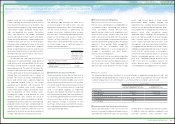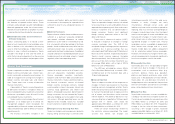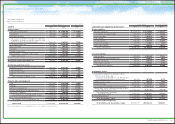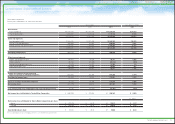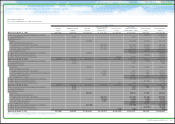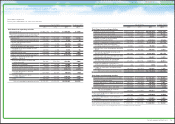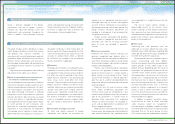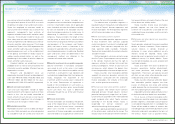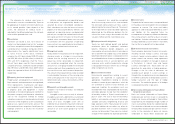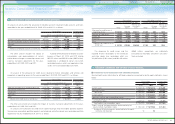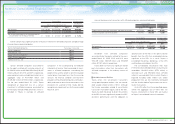Toyota 2011 Annual Report Download - page 76
Download and view the complete annual report
Please find page 76 of the 2011 Toyota annual report below. You can navigate through the pages in the report by either clicking on the pages listed below, or by using the keyword search tool below to find specific information within the annual report.
0822
Financial Section and
Investor Information
Business and
Performance Review
Special FeatureMessage/Vision
Management and
Corporate Information
Notes to Consolidated Financial Statements
return over the term of the related contracts.
The determination of portfolio segments is
based primarily on the qualitative consideration of
the nature of Toyota’s business operations and
finance receivables. The three portfolio segments
within finance receivables are as follows:
The retail receivables portfolio segment consists
of retail installment sales contracts acquired
mainly from dealers (“auto loans”) including credit
card loans. These contracts acquired must first
meet specified credit standards. Thereafter,
Toyota retains responsibility for contract collection
and administration.
Contract period of auto loans primarily range
from 2 to 7 years. Toyota acquires security interests
in the vehicles financed and has the right to
repossess vehicles if customers fail to meet their
contractual obligations. Almost all auto loans are
non-recourse, which relieves the dealers from
financial responsibility in the event of repossession.
Toyota classifies retail receivables portfolio
segment into one class based on common risk
characteristics associated with the underlying
finance receivables, the similarity of the credit
risks, and the quantitative materiality.
Toyota acquires new vehicle lease contracts
originated primarily through dealers. Contract
period of these primarily range from 2 to 5 years.
Lease contracts acquired must first meet specified
credit standards after which Toyota assumes
ownership of the leased vehicle. Toyota is
responsible for contract collection and
administration during the lease period.
Toyota is generally permitted to take possession
of the vehicle upon a default by the lessee. The
residual value is estimated at the time the vehicle is
occurrences of recalls and other safety measures.
During the fourth quarter of fiscal 2010, as a result
of significant changes in facts and circumstances,
Toyota has employed an estimation model, to
accrue at the time of vehicle sale, an amount that
represents management’s best estimate of
expenses related to future recalls and other safety
measures. The estimation model for recalls and
other safety measures takes into account Toyota’s
historical experience and individual occurrences
of recalls and other safety measures. This change
resulted from Toyota’s fiscal 2010 experience with
recalls and other safety measures changes in the
operating processes such as the establishment
of the Special Committee for Global Quality to
address quality-related matters, as well as the
broadening of the number of vehicles subject to
recalls and other safety measures.
Litigation liabilities are established to cover
probable losses on various lawsuits based on the
information currently available. Attorneys’ fees are
expensed as incurred.
Research and development costs are
expensed as incurred. Research and development
costs were ¥904,075 million, ¥725,345 million and
¥730,340 million ($8,783 million) for the years
ended March 31, 2009, 2010 and 2011, respectively.
Cash and cash equivalents include all highly
liquid investments with original maturities of three
months or less, that are readily convertible to
known amounts of cash and are so near maturity
that they present insignificant risk of changes in
value because of changes in interest rates.
Marketable securities consist of debt and equity
securities. Debt and equity securities designated
as available-for-sale are carried at fair value with
first leased. Vehicles returned to Toyota at the end
of their leases are sold by auction.
Toyota classifies finance lease receivables
portfolio segment into one class based on
common risk characteristics associated with the
underlying finance receivables and the similarity
of the credit risks.
Toyota provides wholesale financing to qualified
dealers to finance inventories. Toyota acquires
security interests in vehicles financed at
wholesale. In cases where additional security
interests would be required, Toyota takes
dealership assets or personal assets, or both, as
additional security. If a dealer defaults, Toyota
has the right to liquidate any assets acquired and
seek legal remedies.
Toyota also makes term loans to dealers for
business acquisitions, facilities refurbishment,
real estate purchases and working capital
requirements. These loans are typically secured
with liens on real estate, other dealership assets
and/or personal assets of the dealers.
Toyota classifies wholesale and other dealer
loan receivables portfolio segment into three
classes of wholesale, real estate and working
capital, based on the risk characteristics associated
with the underlying finance receivables.
Impaired finance receivables primarily consist
of wholesale and other dealer loan receivables.
For all classes of finance receivables within
the wholesale and other dealer loan receivables
portfolio segment, a receivable account balance
is considered impaired when it is probable that
Toyota will be unable to collect all amounts due
(including principal and interest) based on current
information and events according to the terms of
the contract. Factors such as payment history,
unrealized gains or losses included as a
component of accumulated other comprehensive
income in shareholders’ equity, net of applicable
taxes. Individual securities classified as available-
for-sale are reduced to net realizable value for
other-than-temporary declines in market value. In
determining if a decline in value is other-than-
temporary, Toyota considers the length of time
and the extent to which the fair value has been
less than the carrying value, the financial condition
and prospects of the company and Toyota’s
ability and intent to retain its investment in the
company for a period of time sufficient to allow for
any anticipated recovery in market value. Realized
gains and losses, which are determined on the
average-cost method, are reflected in the
statement of income when realized.
Security investments in non-public companies
are carried at cost as fair value is not readily
determinable. If the value of a non-public security
investment is estimated to have declined and
such decline is judged to be other-than-temporary,
Toyota recognizes the impairment of the
investment and the carrying value is reduced to
its fair value. Determination of impairment is
based on the consideration of such factors as
operating results, business plans and estimated
future cash flows. Fair value is determined
principally through the use of the latest financial
information.
Finance receivables are recorded at the present
value of the related future cash flows including
residual values for finance leases. Incremental
direct costs incurred in connection with the
acquisition of finance receivables are capitalized
and amortized so as to approximate a level rate of
Cash and cash equivalents
Security investments in non-public companies
Marketable securities
Finance receivables
Retail receivables portfolio segment
Finance lease receivables portfolio segment
Wholesale and other dealer loan receivables
portfolio segment
76TOYOTA ANNUAL REPORT 2011




